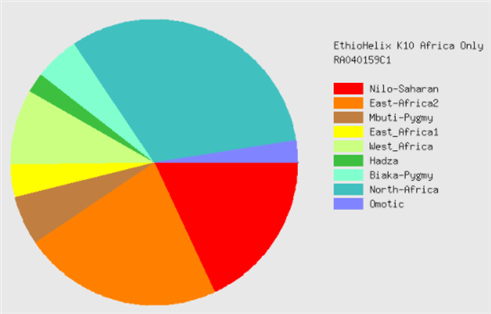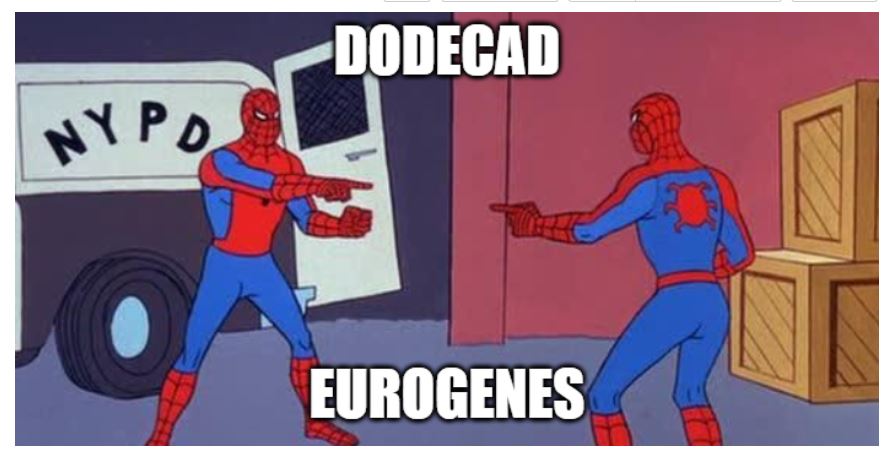The GEDmatch Ethiohelix project is aimed at exploring African heritage. One of the project calculators is for people with 100% African ancestry. The others cater for mixed heritage.
The project includes DNA samples from academic studies, some project volunteers, and ancient archaeological finds. Bear in mind that all the GEDmatch admixture projects explore older eras of human history.
Origins Of The Ethiohelix Project
The Ethiohelix project was created by a blogger with the nickname of Etyopis. The calculators are based on software created for the Dodecad project.
Etyopis also leaned on the work of the HarappaWorld project. The first two projects on GEDmatch were oriented toward east and southern Europe (Dodecad and Eurogenes). HarappaWorld branched out into South Asian ancestry.
The Ethiohelox project set out to have a similar focus on ancient African heritage.
African DNA samples
Etyopis took the data prepared for HarappaWorld and removed all populations that were not from the African continent. This also excluded African-American samples.
You may be wondering where HarappaWorld got its data. The DNA samples were primarily from academic genome studies published in 2010 and 2011. I mention those dates because this project is fixed in time. Back in 2010, the academic studies had a sparse set of African DNA samples. Many communities and regions were entirely missing.
Etyopis also collected samples from volunteers who tested with 23andMe. The Dodecad and Eurogenes projects did similarly, and they received hundreds of DNA samples from their blog readers.
Understandably, Etyopis was only able to gather “a handful of private African samples that took their genetic test with [] 23andMe”.
Unfortunately, this also reduces the quality of this project in terms of adequate representation across the continent.
Ethiohelix K10 African Only
K10 African Only was the first Ethiohelix calculator made available on GEDmatch.
This calculator only uses DNA samples from the African continent to analyze your heritage.
At this point, I can warn you about a feature of all GEDmatch calculators that can seem very misleading. They will always try to fit you into their model. If they can’t find a match for part of your DNA profile, they’ll stick it into the “nearest fit” available.
Let me illustrate with an example. My heritage is half East African and half Irish (all 8 of my maternal 2nd great-grandparents were Irish). And here’s my African Only breakdown:

My 50% European heritage has been dumped mostly into the North-Africa wedge (which I shouldn’t see much of at all). The rest of it has been tossed across some other categories.
I saw the results of a guy who said he was 99% European. This calculator had him at highly North-Africa. So, you can see that North-Africa becomes a catch-all for European heritage.
But that’s not the only problem I have with this calculator. The other calculators in the project have slightly different African populations that seem to align more closely with my known heritage. Other people have reported similar feedback.
Before I look at the other calculators, I’ll show you how to understand the different Ethiohelix populations. Their names can be misleading!
The Ethiohelix Populations
The African Only calculator uses ten populations to analyze your DNA. The other calculators use 10 African populations plus 1 non-African. Let’s take a closer look at how the populations line up.
I’ve laid them out below to show you that some of the population names are common across all four calculators e.g. “Nilo-Saharan”. While East_Africa1 is present in three, and East-Africa2 is only in one calculator.
| African Only | + French | + Japanese | + Palestinian |
| Biaka-Pygmy | French | Japanese | Palestinian |
| East_Africa1 | East-Africa1 | East-Africa1 | |
| East-Africa2 | |||
| Eastern-Bantu | Eastern-Bantu | ||
| Biaka-Pygmy | Biaka-Pygmy | Biaka-Pygmy | |
| Mbuti-Pygmy | Mbuti-Pygmy | Mbuti-Pygmy | Mbuti-Pygmy |
| Hadza | Hadza | Hadza | Hadza |
| Khoi-San | Khoi-San | Khoi-San | Khoi-San |
| North-Africa | North-Africa | North-Africa | |
| Nilo-Saharan | Nilo-Saharan | Nilo-Saharan | Nilo-Saharan |
| Omotic | Omotic | Omotic | Omotic |
| West_Africa | West-Africa | West-Africa | West-Africa |
It’s important to remember that these are “nicknames” for the groups of DNA samples that make up each category. The project creator said that some represented geography and some are a language grouping.
So, what’s the difference between East Africa 1 and East Africa 2? And what does Nilo Saharan mean?
This is what the “Spreadsheet” button is for. You’ll see it above your admixture breakdown.
The Ethiohelix Spreadsheet
Every Oracle spreadsheet shows the reference data that make up the specific calculator you’re working with. The spreadsheet has nothing to do with your own DNA. Everybody sees the same data.
We have a separate tutorial that walks step-by-step through using the Oracle spreadsheet.
The tutorial uses the Dodecad project as an example. But the steps apply to all the spreadsheets.
I’ll walk through an Ethiohelix example here.
Suppose I want to understand more about the West Africa 1 population within the Africa+Palestinian calculator. It’s the 6th population listed across the top row of the Ethiohelix spreadsheet. You then run your eye down the groups on the left, looking for the higher percentages.
Our tutorial shows you how to copy it to a proper spreadsheet, like Excel, which makes it much easier to review. When I get the reference data into Excel, I can put a filter on the column to show groups (rows) with a percentage of above 60.
The shortlist includes hausa, igbo, and yorubu as the higher percentages. Each row of the spreadsheet shows you the admixture breakdown of the DNA cluster across the broad population categories.
You can compare how closely your own admixture breakdown aligns with these rows. If they look close across the board, this becomes an interesting insight. But keep in mind that we’re dealing with older eras of human history.
Obscure groups
There are some very obscure names in the spreadsheet. “EtA”, “EtO”, and “EtT” are some examples. There’s no information on the GEDmatch site as to what these mean.
I searched the original blog for the project to find that these represent Ethiopian (Et) Amharas, Oromos, and Tigrayans respectively. If you’re very interested in other abbreviations, then use the search box on the Blogspot site.
Interpreting Your Ethiohelix Oracle Results
The Ethiohelix projects have both the Oracle and Oracle-4 utilities. You may see references in forums to these utilities not working on GEDmatch. There were problems when the project was first uploaded to the website, but they are working currently.
These utilities can be difficult to understand at your first usage. We have an in-depth walkthrough on using the GEDmatch Oracle here.
Reviewing Other Peoples’ Results
It can be useful to see other people’s results that are similar to your own. This thread on the Anthrogenica forum has people posting their Ethiohelix results.
Some posters don’t describe their known ancestry. But others give details about their background.
Other Project Calculators For African Heritage
I’ve also reviewed some other calculators that focus on African heritage from the perspective of older historical eras. I’ve got a roundup on which GEDmatch calculator is best for African ancestry.
We’ve also covered the various admixture projects with dedicated articles for each. Here are the links:
- Dodecad project (by Dienekes)
- The Eurogenes Project (by Davidski)
- The MDLP project (by Vadim)
- HarappaWorld project (by Zack)
- PuntDNAL project (by Abdullahi Warsame)
- Gedrosia project (by Dilawer Khan)
Ethiohelix And The Calculator Effect
The GEDmatch calculators are based on software and methods devised by Dienekes Pontikos for the Dodecad project.
The Eurogenes project creator made changes to the methods because he perceived there was an underlying flaw with the calculators. Davidksi called this the “Calculator Effect”. The problem would mean that the calculators were only reliable for the people who originally volunteered their samples as reference data.
When Davidski amended his own calculators, he said that every other project that didn’t follow suit would be flawed.
Dienekes of Dodecad rejected these arguments and retorted that any calculator based on Eurogene’s methods would be flawed.
With each calling the other an imposter, we need to roll out double-spiderman.

I don’t actually know whether Ethiohelix followed Dodecad’s methods or that of Eurogenes. My main point is that you shouldn’t take the results too seriously.
Researching Recent African Heritage
I’ve seen considerable recent improvement in the ethnicity breakdown at Ancestry for my own African heritage. Back in 2017, my display was “pinpointed” to vast regions of the continent.
The company has increased its African reference samples in recent updates which allows more granular results. Unfortunately, African results are still nowhere near as localized as European results.
We have an article that takes an in-depth look at Ancestry’s ethnicity estimates. And if you’re wondering there’ll be further improvements, we have another article that looks at how often Ancestry updates the ethnicity estimates.
I hope that these project to be extended to Southern Africa. I would gladly like to be part of it.